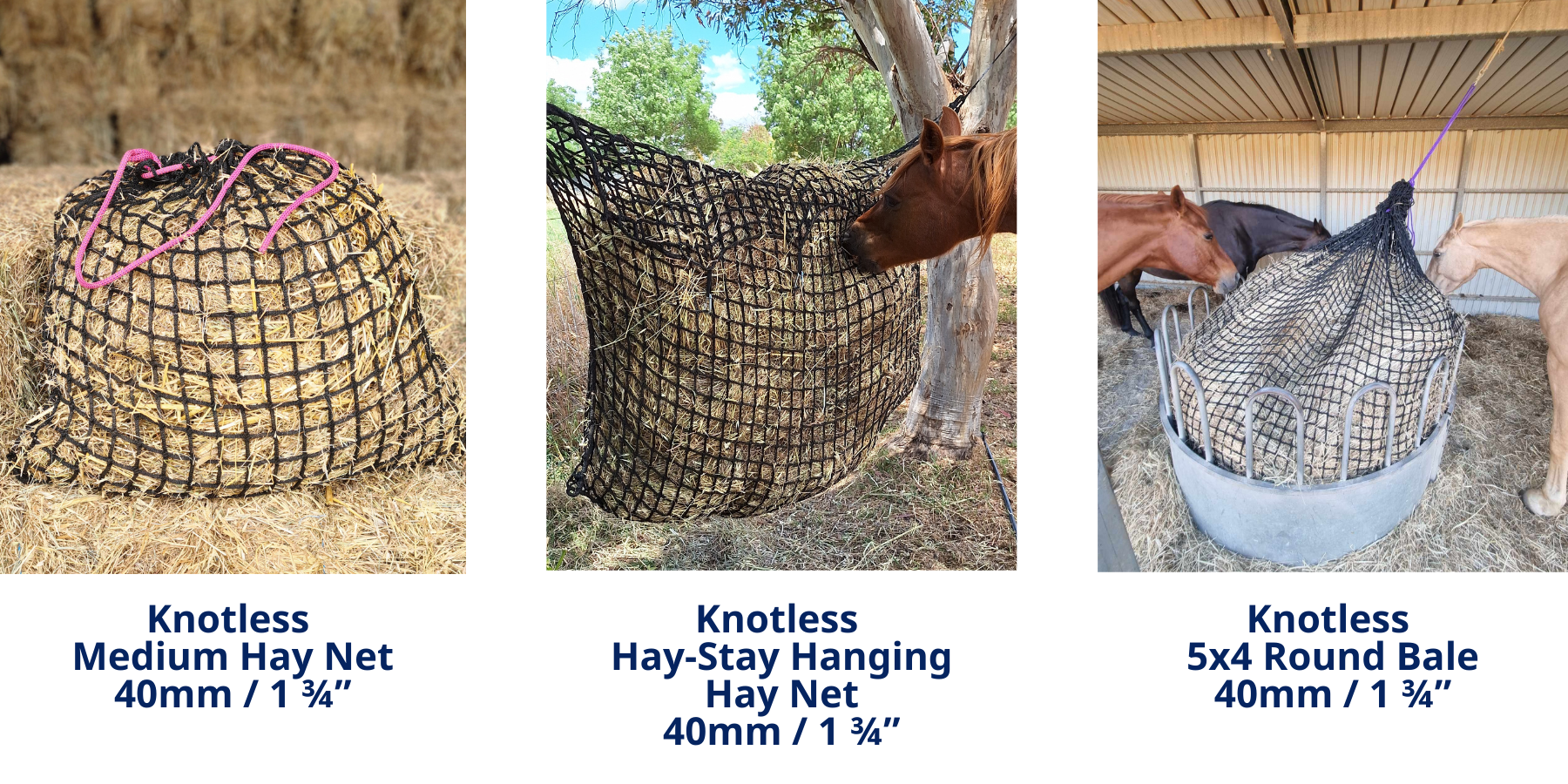Which hole size do I choose?Updated 3 months ago
Considerations for Choosing a Hay Net hole size!
When deciding on what sized hole will suit your horse, pony or livestock there are many factors to take into consideration. This guide will help you understand the different options available in our range, from our larger 60mm / 2 ½” hole nets designed for horses who need easier access to hay, to our smallest 20mm / ¾” hole size for slow feeding and weight management. Below is a breakdown of each hay net hole size, the issues it helps with and the hay types it suits best.
.png)
20mm / ¾” Sized Holes - Extreme Slow Feed
The 20mm / ¾” sized holes is the newest size in our range. This sized hole is purely for extreme 'expert level' status ponies that can still manage to devour from 30mm / 1 ¼” hay nets at quite impressive speeds. Only recommended for horses or ponies that have mastered eating from a 30mm / 1 ¼” hay net. Lucerne for greedy horses or ponies would be good fed in a 20mm / ¾” hay net. This size is only available in the Knotless hay net style.
.png)
30mm / 1 ¼” Sized Holes - Decelerator
This hole size is great for ponies, mini’s and horses that are very voracious eaters. Recommended for horses that have already used a 40mm / 1 ¾” hay net size hay net who therefore understand what slow feed hay nets are about, but need slowing down a little more.
These 30mm / 1 ¼” sized holes are recommended for really gutzy horses or livestock, ponies, or for very palatable hay (not stalky). Lucerne is good hay to feed in 30mm / 1 ¼” nets if you are worried about the consumption rate. Higher sugar and therefore more palatable finer hays are also a good choice for this size.
Great to relieve boredom issues for yarded and stabled horses, or to have as a second net to know that your horse always has something to eat once it empties its first hay net. For example; you may have a small or medium 40mm / 1 ¾” hay net and then a 30mm / 1 ¼” small or medium as a backup so that once your horse finishes the 40mm / 1 ¾” there is still something for it to wander over and eat in the 30mm / 1 ¼”, but consumption rate is slowed a little more.
Depending on the hay type you use and how palatable it is, this isn't a common size for goats, cows, or sheep. However, we do certainly have those animals that do use this size hay net hole with quite yummy and palatable hay.
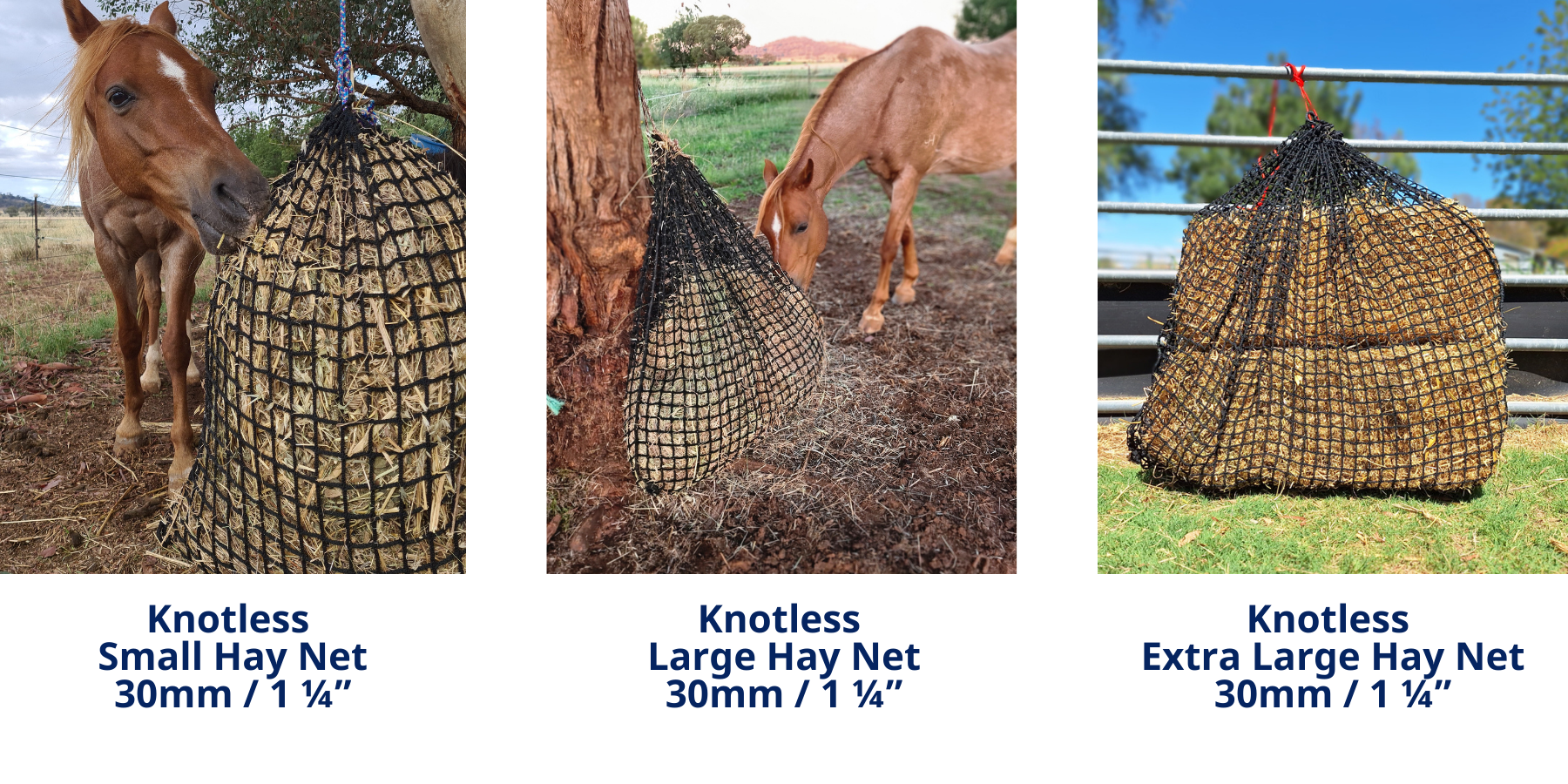
40mm / 1 ¾” Sized Holes - Moderate
Our most popular hole-sized net, the 40mm is a good place to start if you are unsure or new to slow feeding.
Our most popular hole size, 40mm / 1 ¾” it is the ideal starting point if you’re new to slow feeding or unsure where to begin. It delivers genuine slow feeding, enough restriction to extend eating time and reduce waste without tipping into frustration. In our experience, it’s readily accepted by 90% of horses of horses once introduced correctly. Good for slightly stalky hay, where you don't wish to slow down too much but still reap the rewards of hay saving and increasing the longevity of the hay you are feeding out.
A 40mm / 1 ¾” provides balanced control that slows intake to a natural, steady pace, reduces waste, supports a calmer routine with longer nibble time, and offers an easy transition before finer sizes; it’s best suited to pasture and slightly stalky/oaten hays and to good doers, easy keepers, horses new to slow feeding, and mixed herds where one size needs to suit most.
60mm / 2 ½” Sized Holes - Free & Easy
Great hole size for saving on hay without too much restriction. A very common size for hay that isn’t very palatable, such as low sugar hay and also course and stalky hay. Great for older horses, paddock ornaments in good condition (not overweight or underweight), and also cattle (although we do have customers that have used the 40mm / 1 ¾”, and 30mm / 1 ¼” round bale nets for their cattle).
This size will not slow their eating very much, but will drastically save on hay wastage by keeping the hay together and stopping it from being spread all over the place, used as a toilet, bed, or from being blown away.
This size is perfect for pregnant broodmares in good condition, or younger horses that you aren't trying to slow feed, just save on wastage. The caution here is to make sure that the hoof size is larger than the netting size. If you are using a 60mm 2 ½” net with young horses, or broodmares with foals at foot, or any other horse or pony, then make sure their feet are larger than 60mm / 2 ½”. Otherwise, you MUST use a hay ring for round bales, or if using the smaller nets, hang them at a sufficient height to ensure hooves and net are kept separate. More ideas on safety can be found here.
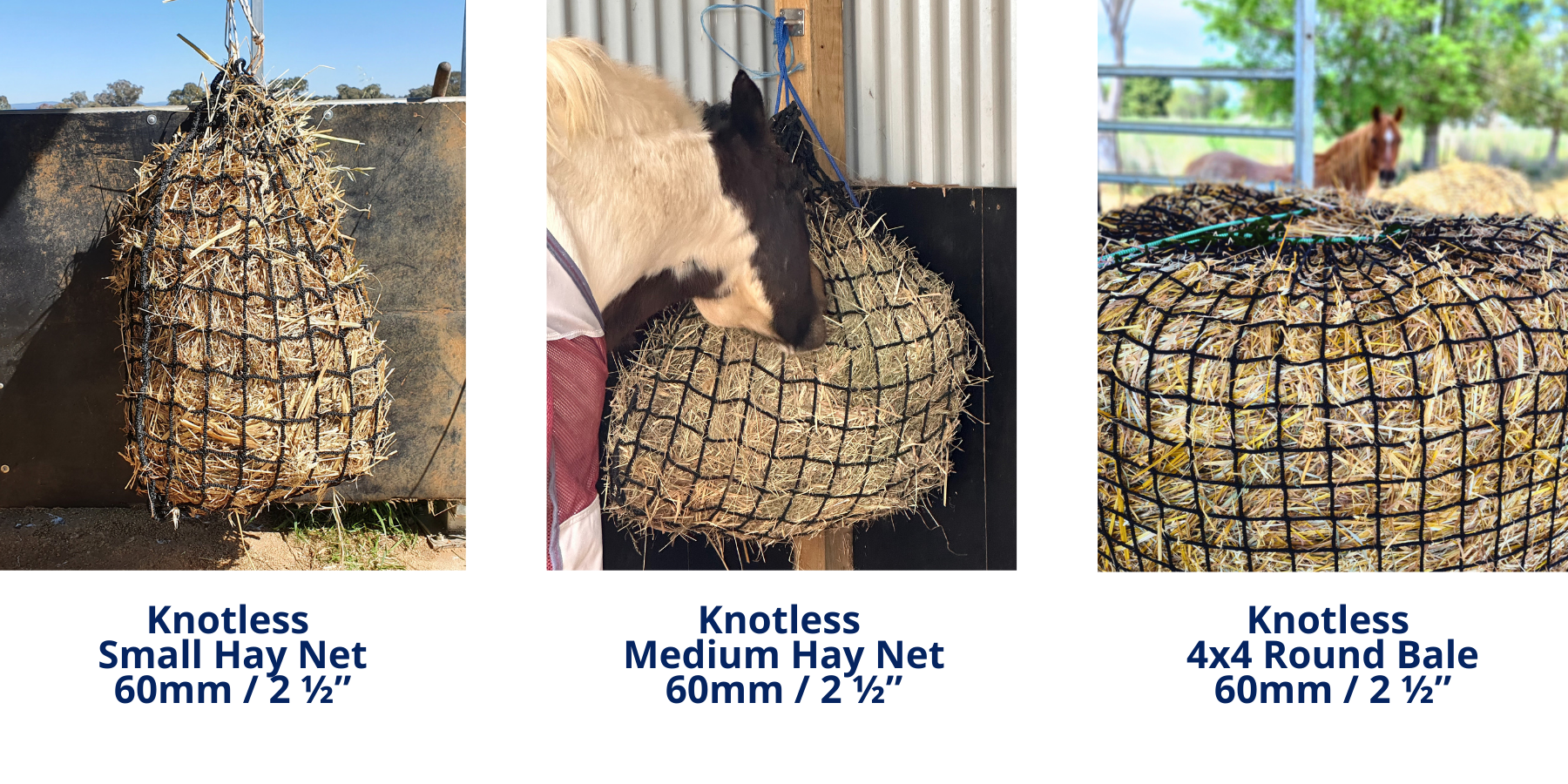
General Considerations:
Laminitic horses and ponies are generally overweight, therefore 30mm / 1 ¼” is usually the best sized hay net if they are used to eating from slow feeders. Having said that, if the hay is not that palatable because it is low in sugar, then you may need a 40mm / 1 ¾”, or even 60mm / 2 ½” to help them eat it. We currently have some 3% and now 6% sugar hay (ESC + Starch), and because it is so low in sugar, it just isn't that palatable so I know I am 100% safe feeding it to laminitic horses and ponies in a 60mm / 2 ½” hay net.
Weather is a major factor to consider too. In the depths of winter, you may not wish to slow your animals down too much, but still save on wastage. Fibre keeps them warm, so a 40mm / 1 ¾” or even a 60mm / 2 ½” hay net might be a better choice. Whereas Springtime and Autumn is a time of rain and prolific growth and therefore a time of year where 30mm / 1 ¼” is more suitable. I personally use 3 sizes (30mm / 1 ¼” to 60mm / 2 ½”) throughout the year.
Another weather consideration that I've personally observed over the years is that the time of year dictates what sized holes the horses will eat particular hay in. For example, we had a low sugar pasture hay that my horses would only eat from a 60mm / 2 ½” hay net in winter, however they would eat it just fine from a 40mm / 1 ¾” in summer.
Type of hay is also important to factor in. Is the hay stalky, if yes then it is best to go a 40mm 1 ¾” or 60mm 2 ½” sized hole. If the hay is fine, then 30mm / 1 ¼” may be a good size.
Palatability is a very important factor to consider when deciding on what sized hole fits best. The more palatable the hay, the smaller the hole size you may be able to go. The less palatable, the larger the hole you will end up needing to go. If you put hay that isn't very palatable into too small of a holed hay net, then a lot of horses will consider it too hard and will not even try. Conversely, if you have a real greedy horse or pony that will eat anything and is locked up with no pick on not so palatable hay, then this type of horse may be an exception to the rule and may still eat through smaller holed nets.
Health Status of the horse is something to also take into consideration. For example if your horse suffers from choke, then 30mm / 1 ¼” would be the best size, and no more than 40mm / 1 ¾”. If the hay is really fine, then you may even consider a 20mm / ¾” so that the horse doesn't get too big of a mouthful of hay at a time.
Weight / Condition of the Animal If the horse, pony or livestock are overweight then smaller sized such as 30mm / 1 ¼”, possibly even 20mm / ¾” hay net holes would be ideal. If the animals are at an ideal weight, then 40mm / 1 ¾” is a good size. If the horses are underweight or retired or paddock ornaments where slow feeding isn't needed, just the need to save on wastage, then 60mm/ 2 ½” is ideal.
An interesting observation that many customers have made is that overweight horses tend to lose weight and underweight horses tend to put on weight when using slow feeders. This phenomenon may be due to the reduced stress on the animals by always having hay available.
Work load is something you want to consider as well. For example, if your horse is in full work and good condition and you have the appropriate hay then a 40mm / 1 ¾” or 60mm / 2 ½”hay net would be ideal as you are not wanting to overly restrict grazing. If your horse is a paddock ornament whose energy needs are not that high, they depending on the hay type, you may go a 30mm / 1 ¼” or 40mm / 1 ¾” size hole.
What are you trying to achieve? If you are wanting to JUST save on wastage but have little to no slow feed effect, then choose a 60mm / 2 ½”. If you are wanting some slow feeding effect but not to frustratingly slow, then a 40mm / 1 ¾” is ideal. If you are wanting to slow down a very gutzy eater, then 30mm/ 1 ¼” is the best size for experienced hay net users. If you truly have a SUPER gutzy eater that even manages to master a 30mm / 1 ¼”, then you may consider a 20mm / ¾” net or double bagging a 40mm / 1 ¾” or 30mm / 1 ¼” net could also be an option.
Don't over-face your horse! Monitor your animals for how they respond when you first introduce a hay net. Make sure they work out within the first day or so how to eat from the net and eat reasonably well. Things to watch out for is if you do start with a 30mm / 1 ¼” net and the hay isn't palatable enough then the horse may refuse to eat from the net. This is an unwanted situation and you have over-faced your horse. It doesn't mean your horse will not eat from or accept a hay net, you have just started with too small of a hole. Try a 40mm / 1 ¾” next.
There are things you can do to assist your horse on introduction to a new net to, like making sure they have some loose hay with their hay net and if they seem to be having difficultly then you can pull some strands of hay through to help them out with the concept. Most horses accept a hay net within the first few hours and hole size is usually the biggest factor in determining acceptance.
Livestock Our hay nets are commonly used by hobby farmers who don't want their hay wasted and with livestock such as cattle, sheep, alpaca's and goats. Please be mindful of horns (entanglement) and ear tags that can be rubbed out. We have the odd feedlot also using our nets.
Surprisingly many of these animals are capable of eating from the 30mm / 1 ¼” sized nets, however 40mm / 1 ¾” is the most common size. Again it comes down to what you are aiming for! If saving on wastage is your primary concern, then 60mm / 2 ½” is ideal. If you are wanting to regulate and save on wastage then 40mm / 1 ¾” is ideal and if you are really wanting to slow them down, then 30mm / 1 ¼” is suggested.
For more photos of Livestock eating from our hay nets, please click here.
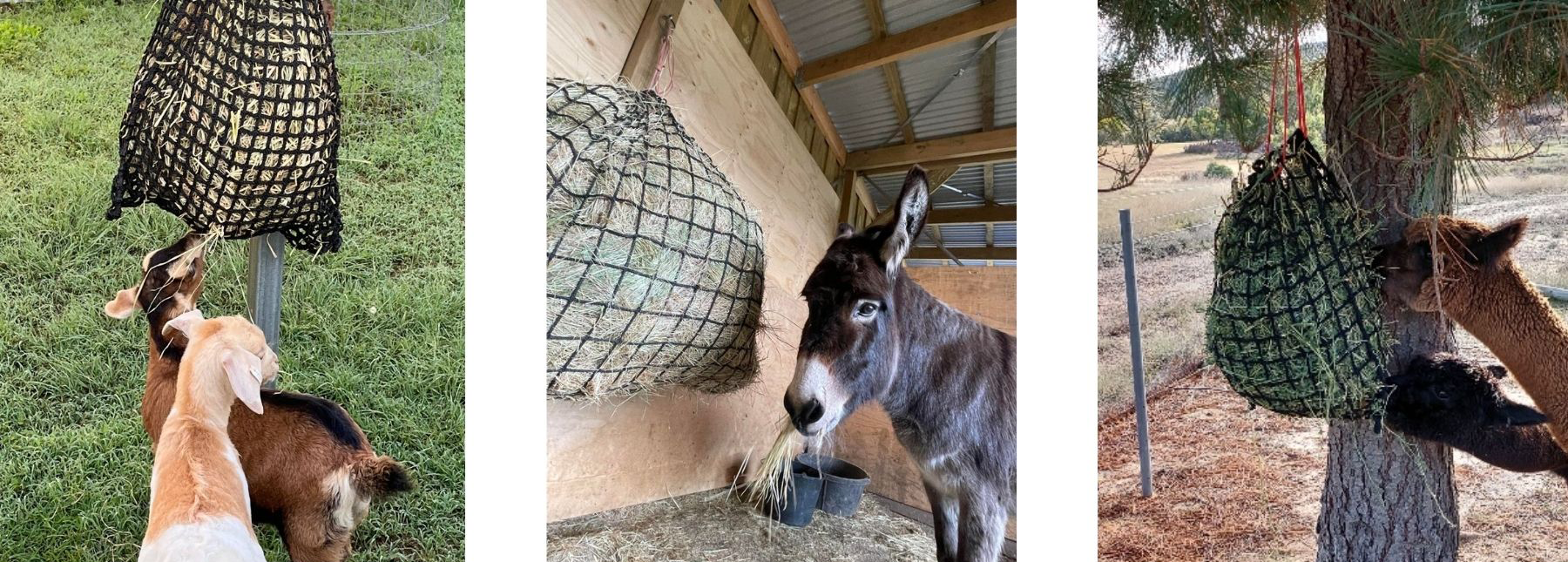
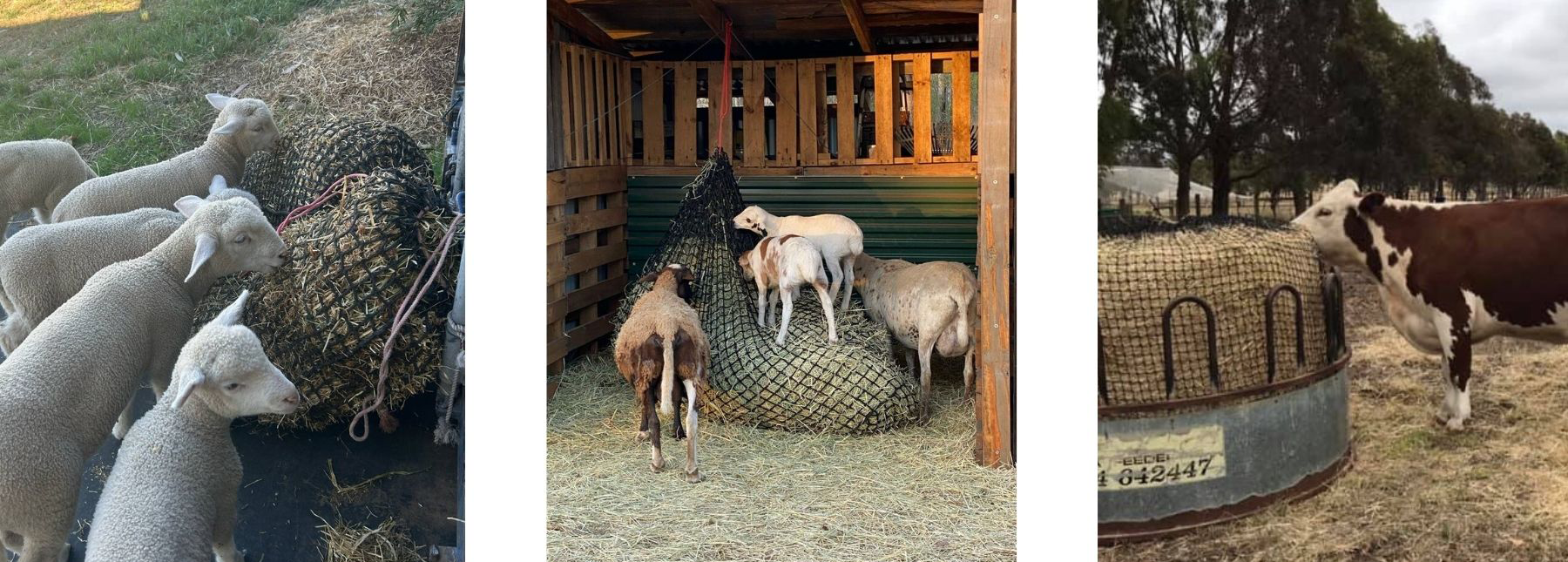
Final thoughts
GutzBusta 40mm / 1 ¾” sized holes are a good place to start if you are still not sure. You can then go up or down a size if needed. No matter what you purchase, it won't go to waste as from all of the factors discussed above, you will use different sized holes at different times of the year, with different hays, for different health status's and to manage weight due to seasonal issues. So don't stress if you order the wrong size, you will use it another time!
Some animals may initially spend the first week or two attached to their hay net, but once they know that there is always hay available (if you are fortunate enough to have the correct hay that enables 24/7 feeding, or you are using round bales) then they will settle and lose their anxiousness about feed time. Many customers report happier, less aggressive behaviour of the herd.
Caution:
If your horses are shod, then we recommend that you must use a hay ring/feeder or barrier of some sort around your square bale and GutzBusta® Round Bale Net or you use some other construction that keeps your horses feet from getting involved with the hay net. Not recommended for horned livestock. Remove all halters/headstalls from horses so there is nothing to get caught on if your horse loves rubbing its head and body on the bale (like one of ours does).
| Hay Net Hole Size | Recommended for | Ideal Hay Types | Purpose |
|---|---|---|---|
| 2cm / ¾" | Expert level ponies | Lucerne or soft, fine, very palatable pasture hay (for greedy horses/ponies) | Extreme slow feeding |
| 3cm / 1 ¼" | Ponies, miniatures, voracious eaters | Non-stalky, palatable hay | Boredom relief, continuous feeding |
| 4cm / 1 ¾" | Most horses and livestock. | Slightly stalky hay, and most hay types where the horses aren’t greedy eaters. | Entry level slow feeding size for horses and ponies that aren’t greedy eaters. |
| 6cm / 2 ½" | Older horses, paddock ornaments, youngstock (watch hoof to net size), pregnant broodmares, & underweight horses, and cattle. | Low sugar, coarse, stalky hay | Reduces wastage by keeping hay confined, minimal to no slow feeding affect. |
Our GutzBusta® Knotless Hay Net range consists of:
- 2cm x 2cm square holes (8th of an inch) - not available in knotted - ¾” x / ¾” sized holes.
- 3cm x 3cm square holes (1″ square) - 1 ¼” x / 1 ¼” sized holes.
- 4cm x 4cm square holes (1.5″ square) - 1 ¾” x / 1 ¾” sized holes.
- 6cm x 6cm square holes (2.3″ square) - 2 ½” x / 2 ½” sized holes.
Join up to our mailing list to receive much more in depth articles on using slow feeders for your horses and livestock and also general horse health and information. 😄
